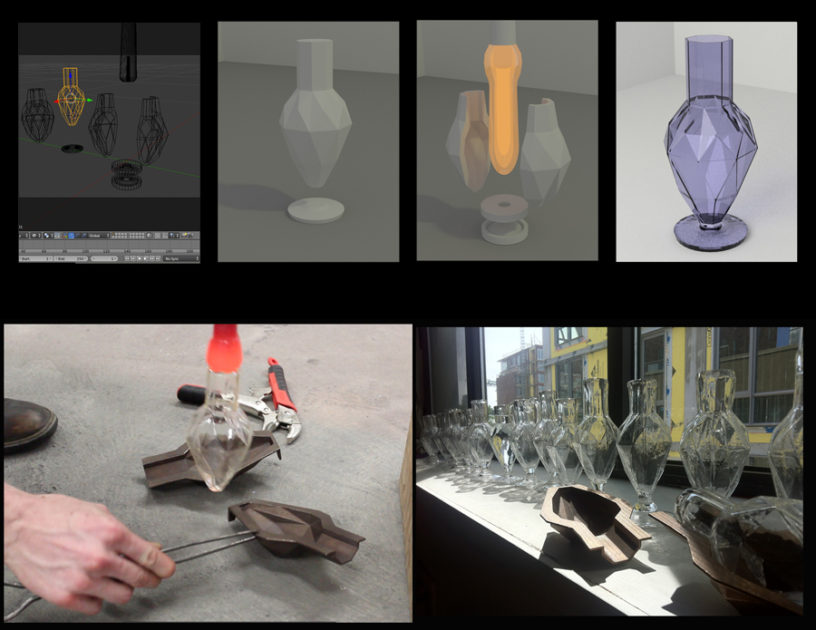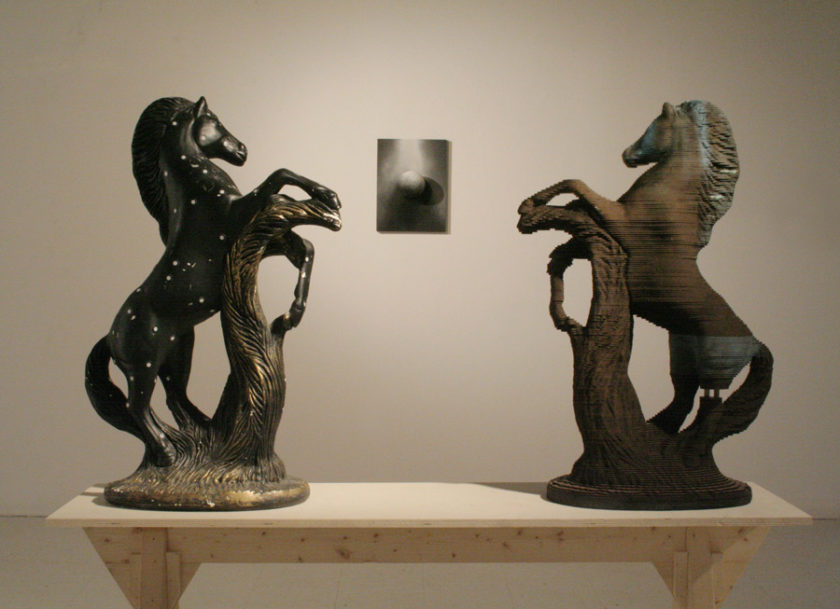In the art world, the debate around handmade and machine-made products is certainly a heated one. But after an extensive research project focusing on the different perspectives in glass making, artist and educator Tim Belliveau knew how efficient and beneficial 3D printing was to his art form.
“I wanted to see my training in glass from a different perspective and make some understanding of the 3D printers that I started to see popping up in glass studios around 2014,” Belliveau told Shapeways. “I was also inspired to use 3D printing in my research because I was traveling a lot and it was becoming difficult to store and travel with material things. It caused me to kind of ‘compress’ my practice down to the basic ideas and images I wanted and find ways for even glassblowing to be represented in 3D software as small, portable files and small tools rather than big, heavy materials and equipment.”
His first attempt at 3D printing
Prior to his teaching career, Belliveau received his Masters of Fine Arts at Concordia University in Montreal in Fibers and Material Practices. With the help of Shapeways’ EDU discount, he was able to explore an avenue of 3D printing that he’d never experienced before.
“I wanted to use 3D printed metal for my mold at a scale that was big enough to fit blown glass and thin enough to stay on budget. I also wanted to test out how an ancient craft like glass can interact with newer 3D printing tools. I teach with it as a skill-building tool, but also to instigate thinking around skill, technology, and art,” he said. “The EDU discount made my project possible and without it, I would likely have had to do the more common method of casting positives and negatives and hiring a foundry to produce what I needed.”

Tim Belliveau’s two-part mold for glass blowing, made from 3D printed bronze
Belliveau never expected to love 3D printing as much as he now does. After completing his research project and launching his teaching career, he began to incorporate 3D printing into every one of his classes.
“This project tested the skills and thinking needed to get from 3D modeling to glass forms. I use 3D printing for teaching almost every class now. Once students get through the interfaces of various software and can intuitively sketch with it, the possibilities really expand but at the beginning, its more about learning through accidents and working with mistakes rather than getting perfection. This project sent me on a path of asking more questions about this process and trying to find less deterministic ways to use technologies like this.”
Overcoming the obstacles of being a beginner 3D designer
Like Belliveau explained, learning how to use 3D printing comes with its fair share of challenges and obstacles. Overcoming these difficulties, however, is what taught him a great deal about the craft.
“It was challenging at first to blow into this 3D printed mold in part because the opening is narrow. A very hot bubble of glass has to be stretched through the neck of the mold and inflated perfectly into the chamber. That took a lot of practice. I spent a lot of time shaping and thinning the model in my software to guess at what the minimum thickness could be,” Belliveau said.
The final outcomes have been extraordinary
Among the many products he’s made using 3D printing, one of his favorites has to be the “monuments” he constructed during his residency at the European Ceramics Work Centre last year.

Deconstructing 3D print processes: using the plaster horse (left), Tim Belliveau 3D scanned and printed a new one (right)
“I’ve been kind of deconstructing 3D print processes, using more labour and trying to make it harder. During my residency at The European Ceramics Work Centre last year, I modeled a polygon and used software to unfold that shape into faces, projected it onto cardboard, cut that out, traced it into clay panels and assembled those together making the original polygon form again. The finished artworks, called ‘Monuments,’ have a trace of computer design but mostly, hand-marks and textures that come from forming it. You might not guess it came from computer modeling by looking at it and they were very challenging to make but also very rewarding.”
Reflecting on his journey with 3D printing, now utilizing it in every class he teaches, Belliveau said, “I wish I knew how to do 3D printing sooner! As with most skills, it’s not as intimidating as it might seem as long as you’re interested enough to spend the time and learn. It’s very accessible and, in some cases, very cheap to do.”
Are you a student or a teacher?
You may be eligible for a 15% discount through our EDU program. Learn more.
The post How 3D Printing Changed The Way Artist Tim Belliveau Teaches His Students appeared first on Shapeways Magazine.


30 Replies to “How 3D Printing Changed The Way Artist Tim Belliveau Teaches His Students”
Comments are closed.